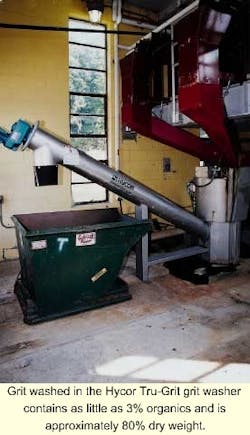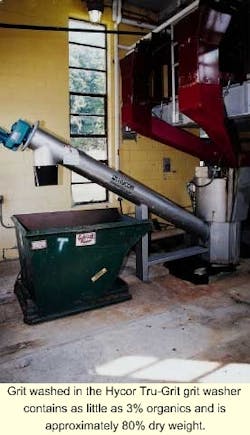HYCOR-WASHERS: Washers Clean Up Grit, Screenings Problems
Residuals from grit traps and bar screens were an expensive nuisance for the West Lafayette Wastewater Treatment Plant, a 9 mgd facility in Indiana. The facility paid for 23 hauls of grit a year with each dumpster averaging 8.2 tons. This totaled 188.6 tons at a cost of $33.80 per ton.
Screenings from a bar screen with 3/8 inch openings also generated hauling and landfill costs. The plant filled 22 dumpsters a year, each averaging 4.3 tons. The cost of removal was $27 per ton.
Not only were these residuals expensive to handle, but the dumpsters that stored them were wet, unpleasant, malodorous and a breeding ground for insects and vermin. None of the operators wanted to go into the grit or screening rooms because of the flies and odors. The source of the problem was putrescible organics, including fecal matter and septic biosolids, which hinder drainage and create obnoxious odors in screenings and grit.
Removing the organics solved the problem. To accomplish this, the municipality selected a Hycor® Tru-Grit® grit washer and a Hycor®Heliclean® screenings washer. The washers reduced the volume and weight of the residuals, alleviated odors and cut the number of dumpsters going to the landfill by 80%.
The Tru-Grit washer works by settling, with the grit creating its own filter bed that separates out the organics. The organics are caught up in the washwater, which sweeps them out and directs them to further treatment. The cleaned grit drains and dewaters as it is conveyed to discharge. Grit washed in the system contains minimal putrescible material and is up to 80% dry solids.
The WWTP collects the washed grit in a 0.5 yard dumpster and then transfers it to a 15 yard dumpster. The washed grit has very little odor, no free water and minimal fly and vector attraction. The grit now accumulates without operator and neighbor complaints. The plant empties the dumpster at a local transfer station once every three months.
The Heliclean screenings washer uses turbo-agitation to remove organics from the screenings. Washing greatly reduces the weight and volume of the screenings. Now, the plant needs only a 1.5 yard trash dumpster to catch the screenings. They are dry and no longer contain large, identifiable pieces of organic materials, so disposal has ceased being a problem. Although the dumpster can hold two weeks worth of screenings, it is emptied weekly and no longer requires special handling.

